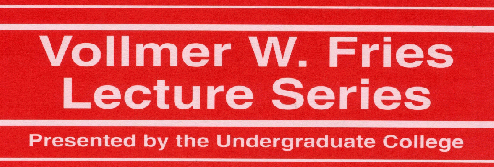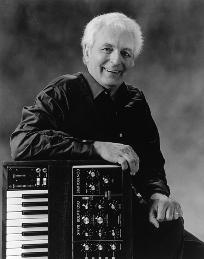Last Updated 9 September 1996

Recognizing that both the activities and the aspirations of present and future
generations of Rensselaer faculty and students can and must be expanded by
inspiration and insight derived from contact with distinguished engineers,
scientists, architects, and managers, Mr. Vollmer W. Fries established a fund
in 1973, the income from which will be used to bring such scholars to the
campus.
Lectures During the 1995-1996 Academic Year
All Vollmer Fries Lectures are Open to the General Public. See Below for
Directions to Campus and Information on Visitor Parking
SPECIAL SEMINAR AND DOCUMENTARY SHOWING ON THE FIRST ELECTRONIC INSTRUMENT: THE
Theremin
Dr. Robert Moog -- Monday, 1 April 1996, 4:00 pm, Room 308,Darrin Communication Center
Dr. Moog, the inventor of the Moog Synthesizer, an early electronic musical instrument used in many well-known recordings of the 1970s and 1980s, discussed the history of electronic instruments, with particular emphasis on the Theremin.
Abstract of
Synthetic Sound and Real Music
A History of Electronic Music Technology
by Robert Moog
 Throughout the history of technology, musical instrument builders have always used the most advanced technology of their time. In the 20th centruy the dominant technology has been electronics. Vacuum tube electronics, magnetic recorders, semiconductors, and computers, all have been used to produce music.The attributes of these technologies were discussed which have been particularly useful for making musical instruments, and how the musical utility of these technologies differs from that of wood- and metal-working.
Throughout the history of technology, musical instrument builders have always used the most advanced technology of their time. In the 20th centruy the dominant technology has been electronics. Vacuum tube electronics, magnetic recorders, semiconductors, and computers, all have been used to produce music.The attributes of these technologies were discussed which have been particularly useful for making musical instruments, and how the musical utility of these technologies differs from that of wood- and metal-working.
One of Dr. Moog's theremin kits, obtained from his company Big Briar, Inc. was given away at his talk. The winner was be invited to attend the Workshop, described below.
"Theremin: An Electronic Odyssey" -- Monday, 1 April 1996, 7:30 - 9:00pm, Room 308,Darrin Communication Center.

"Theremin: An Electronic Odyssey" is a feature length documentary film about the life and work of Professor Leon Theremin, the Russian electronics genius who virtually created the entire field of electronic music in 1920 with the introduction of the world's first electronic musical instrument, the THEREMIN. Amazingly played without being touched, the theremin was the first application of electronic technology to the arts and set the music world on its ear at concerts throughout the world, including a personal demonstration for Lenin at the Kremlin as well as sold out shows at Royal Albert Hall in London, the Paris Opera House, and Carnegie Hall in New York City.
"Theremin: An Electronic Odyssey," distributed by Orion Home Video, has been availble in video stores since March 26. Orion graciously donated copies of the video to the Vollmer Fries Lecture Series.
Additional information on the Theremin
Theremin-Building Workshop -- Tuesday, 2 April, 1996, 11:00 am, CII 3045
Circuits for Space Music
How to Design a Theremin
Presented by Dr. Robert Moog
Leon Theremin's original instrument used a 'beat-frequency osciallator' circuit to produce a harmonically rich musical tone, which could be controlled through its exceptionally wide pitch and dynamic range merely by the motion of the player's hands in space. Today's theremins work the same way, but use transistors instead of vacuum tubes. Leon Theremin tailored his circuit to produce a musically rich waveform, and added antenna circuity to reproduce wide-range space control.

Pierre Théberge -- Monday, 2 October 1995, 4:00 pm, Room 324, Darrin Communication Center
Monsieur Théberge is the director of the Montreal Museum of Fine Arts. He spoke
on his wonderful exhibit "Moving Beauty," which brings together for the first
time an "impressive collection of fifty of the finest, boldest and most extravagent
automobiles ever built."
Moving Beauty
Information on the exhibit can be found in the homepage
of the museum:
by clicking on "What's New." A real favorite is the 1921 Rumpler Tropfenwagen, which has the same aerodynamic efficiency as a Lexus LS400 . There
are also Bugattis, a Tucker, a Cord, and many other amazing cars in this collection,
which runs through 15 October.
Thanks to the generosity of Hemmings Motor News, a classic vehicle was on display from 1 pm to 4 pm outside the DCC on the day of the lecture.
We organized a bus trip to Montreal on 10 October, to permit members of the Rensselaer community (especially undergraduate students) to visit the exhibit.
If you are interested, you can read some poorly edited emailed comments by students on the first Vollmer Fries lecture.

John Allen Paulos -- Monday, 13 November 1995, 4:00 pm, Room 324, Darrin Communication Center
Professor Paulos is the author of the bestsellers "Innumeracy," "Beyond
Innumeracy," and "A Mathematician Reads the Newspaper" and several other
widely acclaimed books. He describes his talk in the following abstract.
Cover of Innumeracy
Cover of A Mathematician Reads The Newspaper
Abstract of Innumeracy, Newspapers, and Democracy
by John Allen Paulos
My talk will deal with the consequences of mathematical
illiteracy in real life, especially with instances of quantitative
naivete in the daily newspaper, and with ideas for improving
mathematics education and civic understanding suggested by these
examples of innumeracy. Topics addressed will include stock scams,
parapsychological claims, medical testing, sex discrimination,
coincidences and chance encounters.
Specifically with regard to newspapers, I will show how the
notions of probability and randomness can enhance articles on
crime, health risks, or other societal obsessions; how logic and
self-reference may help to clarify the hazards of celebrity and
spin-doctoring; how business finance and simple arithmetic point up
consumer fallacies, electoral tricks, and sports myths; how chaos
and non-linear dynamics suggest that economic and environmental
prediction is always difficult and frequently worthless; and how
mathematically pertinent notions from philosophy and psychology
provide critical perspective on a variety of public issues.
Samuel Johnson would have understood the point. Boswell quotes
him as saying, "A thousand stories which the ignorant tell, and
believe, die away at once when the computist takes them in his
gripe."
If you are interested, you can read some poorly edited emailed comments by students on the second Vollmer Fries lecture.
Information for Campus Visitors:
- Please go to Welcome to Rensselaer where you will find Travel Directions to Rensselaer and Visitor's Parking information. Note that, usually, the CDTA bus that runs from the Fieldhouse parking area to the main campus is only for people with Rensselaer ID cards. However, if you decide to park in the Fieldhouse lot for a Vollmer Fries Lecture, you can ride the shuttle bus.
- Contact for Information or Corrections:
- Professor Kenneth A. Connor (connor@rpi.edu)



